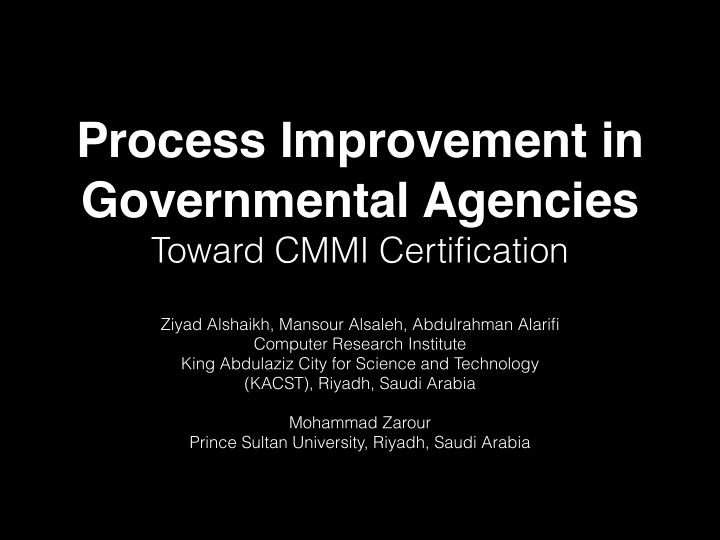



Process Improvement in Governmental Agencies Toward CMMI Certification Ziyad Alshaikh, Mansour Alsaleh, Abdulrahman Alarifi Computer Research Institute King Abdulaziz City for Science and Technology (KACST), Riyadh, Saudi Arabia Mohammad Zarour Prince Sultan University, Riyadh, Saudi Arabia
Outline • Introduction • Software Industry in Saudi Arabia • Appraisal Method • Appraisal Results and Analysis • Insights and Limitations • Summary and Future Work
Introduction • The purpose of our work is to evaluate the process maturity of the software industry in Saudi Arabia. • We selected two small—medium size software development entities. • We selected 3 out of 22 CMMI-Dev process areas. CMMI-DEV is formed by four categories (Process Management, Project Management, Engineering, and Support) and 22 process areas.
Software Industry of Saudi Arabia • Software development is mostly developed offshore ( e.g., Egypt, Jordan). • Critical government software is developed in- house. • The government plans to spend over $3 billion to develop its e-government program.
Appraisal Method • The appraisal is based on the CMMI-DEV constellation. • The objective is of the appraisal is (1) identify gaps, and (2) estimate cost based on time and effort. • Entity A was appraised using SCAMPI C, and entity B was appraised using SCAMPI B.
Appraisal Method • Appraisal steps: 1. Prepare 2. Plan 3. Conduct appraisal 4. Analyze findings 5. Report results
Appraisal Method
Appraisal Results and Analysis 1. Develop architecture requirements to capture critical quality attributes and its measures. 2. Allocate design constraints to product components and the architecture. 3. Identify quality attributes that have architecture significance according to key mission and business drivers. 4. Assess the cost and risks of architecturally significant requirements on the product. 5. Create a screening criteria to select alternative solutions and evaluate each alternative solution against operational concepts and scenarios.
Appraisal Results and Analysis 6. Update the selection criteria and evaluate its adequacy regularly to select the best alternatives. 7. Identify requirements and quality attributes associated with each alternative solution and maintain a record of solution rationale. 8. Establish and maintain a criteria to evaluate design. 9. Document architecture views. 10. Establish criteria to define interfaces and apply it. 11. Evaluate design alternatives and document the design rationale for each selection.
Requirement Development Results A B
Technical Solution Results A B
Verification Results A B
Insights • Entity A and B have not been exposed to a CMMI appraisal before, but their compliance to CMMI processes is hight (%75 or higher). • Both entity A and B did not expect to be CMMI compliant. Yet, after going through the appraisal they became less encouraged to conduct further appraisals. • Our results may indicate early signs of market maturity.
Limitations • Our appraisal is limited to three process areas out of 22. • Our appraisal is conducted under appraisal level C and B. • Entity A in particular were more reluctant to share information which limited our ability to verify some of the results.
Summary and Future Work • We conducted two appraisals on government agencies, we aim to expand our study to government and private institutions. • Although the two agencies have only recently started software development, they have shown significant signs of process maturity. • If new software teams start with high level of maturity what does that mean for SPI approaches?
References • A recent report on the software industry of Saudi Arabia is going to be published by IDC 2015.
References • A report on free and open source software in Saudi Arabia is published by IDC 2012.
Recommend
More recommend